Bio unit 5 cells - Study guides, Class notes & Summaries
Looking for the best study guides, study notes and summaries about Bio unit 5 cells? On this page you'll find 282 study documents about Bio unit 5 cells.
Page 2 out of 282 results
Sort by
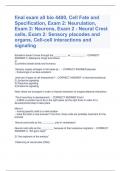
-
final exam all bio 4400, Cell Fate and Specification, Exam 2: Neurulation, Exam 2: Neurons, Exam 2 - Neural Crest cells, Exam 2: Sensory placodes and organs, Cell-cell interactions and signaling
- Exam (elaborations) • 95 pages • 2024
-
- $30.49
- + learn more
final exam all bio 4400, Cell Fate and Specification, Exam 2: Neurulation, Exam 2: Neurons, Exam 2 - Neural Crest cells, Exam 2: Sensory placodes and organs, Cell-cell interactions and signaling Ectoderm doesn't move through the __________ or __________ - CORRECT ANSWER 1) blastopore (frogs and fishes) or 2) primitive streak (birds and humans) Sensory organs all begin in the head as... - CORRECT ANSWER placode - thickenings of surface ectoderm what are 4 types of cell interact...
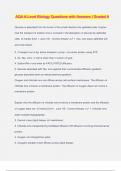
-
AQA A-Level Biology Questions with Answers | Graded A
- Exam (elaborations) • 21 pages • 2024
-
- $12.49
- + learn more
AQA A-Level Biology Questions with Answers | Graded A Glucose is absorbed from the lumen of the small intestine into epithelial cells. Explain how the transport of sodium ions is involved in the absorption of glucose by epithelial cells. (5 marks) [Unit 1, June 16] - Correct Answer ️️ -1. Na+ ions leave epithelial cell and enter blood; 2. (Transport out is by) active transport / pump / via carrier protein using ATP; 3. So, Na+ conc. in cell is lower than in lumen (of gut); 4. Sodium/N...

-
BIO UNIT 5: CELLS, ATP AND LIPIDS STUDY GUIDE.
- Exam (elaborations) • 10 pages • 2023
-
- $12.49
- + learn more
BIO UNIT 5: CELLS, ATP AND LIPIDS STUDY GUIDE. bPART 1: CELLULAR ENERGY (ATP, CARBOHYDRATES & LIPIDS) MCAS HS-LS1-5. Use a model to illustrate how photosynthesis uses light energy to transform water and carbon dioxide into oxygen and chemical energy stored in the bonds of sugars and other carbohydrates. HS-LS1-7. Use a model to illustrate that aerobic cellular respiration is a chemical process whereby the bonds of food molecules and oxygen molecules are broken and new bonds form, resultin...
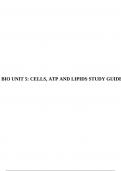
-
BIO UNIT 5: CELLS, ATP AND LIPIDS STUDY GUIDE.
- Exam (elaborations) • 10 pages • 2023
-
- $12.99
- + learn more
BIO UNIT 5: CELLS, ATP AND LIPIDS STUDY GUIDE. bPART 1: CELLULAR ENERGY (ATP, CARBOHYDRATES & LIPIDS) MCAS HS-LS1-5. Use a model to illustrate how photosynthesis uses light energy to transform water and carbon dioxide into oxygen and chemical energy stored in the bonds of sugars and other carbohydrates. HS-LS1-7. Use a model to illustrate that aerobic cellular respiration is a chemical process whereby the bonds of food molecules and oxygen molecules are broken and new bonds form, resultin...
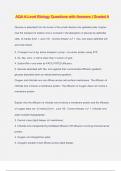
-
AQA A-Level Biology Questions with Answers | Graded A
- Exam (elaborations) • 21 pages • 2024
-
- $12.49
- + learn more
AQA A-Level Biology Questions with Answers | Graded A Glucose is absorbed from the lumen of the small intestine into epithelial cells. Explain how the transport of sodium ions is involved in the absorption of glucose by epithelial cells. (5 marks) [Unit 1, June 16] - Correct Answer ️️ -1. Na+ ions leave epithelial cell and enter blood; 2. (Transport out is by) active transport / pump / via carrier protein using ATP; 3. So, Na+ conc. in cell is lower than in lumen (of gut); 4. Sodium/N...
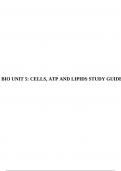
-
BIO UNIT 5: CELLS, ATP AND LIPIDS STUDY GUIDE.
- Exam (elaborations) • 10 pages • 2023
-
- $12.99
- + learn more
BIO UNIT 5: CELLS, ATP AND LIPIDS STUDY GUIDE. bPART 1: CELLULAR ENERGY (ATP, CARBOHYDRATES & LIPIDS) MCAS HS-LS1-5. Use a model to illustrate how photosynthesis uses light energy to transform water and carbon dioxide into oxygen and chemical energy stored in the bonds of sugars and other carbohydrates. HS-LS1-7. Use a model to illustrate that aerobic cellular respiration is a chemical process whereby the bonds of food molecules and oxygen molecules are broken and new bonds form, resultin...
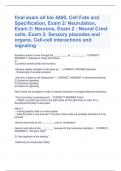
-
final exam all bio 4400, Cell Fate and Specification, Exam 2: Neurulation, Exam 2: Neurons, Exam 2 - Neural Crest cells, Exam 2: Sensory placodes and organs, Cell-cell interactions and signaling
- Exam (elaborations) • 95 pages • 2024
-
- $20.49
- + learn more
final exam all bio 4400, Cell Fate and Specification, Exam 2: Neurulation, Exam 2: Neurons, Exam 2 - Neural Crest cells, Exam 2: Sensory placodes and organs, Cell-cell interactions and signaling Ectoderm doesn't move through the __________ or __________ - CORRECT ANSWER 1) blastopore (frogs and fishes) or 2) primitive streak (birds and humans) Sensory organs all begin in the head as... - CORRECT ANSWER placode - thickenings of surface ectoderm what are 4 types of cell interact...
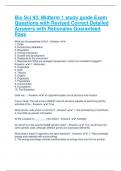
-
Bio Sci 93: Midterm 1 study guide Exam Questions with Revised Correct Detailed Answers with Rationales Guaranteed Pass
- Exam (elaborations) • 19 pages • 2024
-
Available in package deal
-
- $17.99
- + learn more
Bio Sci 93: Midterm 1 study guide Exam Questions with Revised Correct Detailed Answers with Rationales Guaranteed Pass What are the properties of life? - Answers - 1. Order 2. Evolutionary adaptation 3. Regulation 4. Energy processing 5. Growth and development 6. Response to the enviroment 7. Reproduction What are emergent properties in order from smallest to biggest? - Answers - 1. Molecules 2. Organelles 3. Cells 4. Tissues 5. Organs 6. Organisms 7. Populations 8. Communities ...

-
final exam all bio 4400, Cell Fate and Specification, Exam 2: Neurulation, Exam 2: Neurons, Exam 2 - Neural Crest cells, Exam 2: Sensory placodes and organs, Cell-cell interactions and signaling
- Exam (elaborations) • 95 pages • 2024
-
- $30.49
- + learn more
final exam all bio 4400, Cell Fate and Specification, Exam 2: Neurulation, Exam 2: Neurons, Exam 2 - Neural Crest cells, Exam 2: Sensory placodes and organs, Cell-cell interactions and signaling Ectoderm doesn't move through the __________ or __________ - CORRECT ANSWER 1) blastopore (frogs and fishes) or 2) primitive streak (birds and humans) Sensory organs all begin in the head as... - CORRECT ANSWER placode - thickenings of surface ectoderm what are 4 types of cell interact...
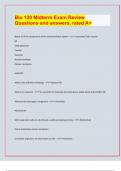
-
Bio 120 Midterm Exam Review Questions and answers, rated A+/ Examminable Questions and answers For 2024/25. Rated A+
- Exam (elaborations) • 24 pages • 2024
-
- $9.49
- + learn more
Bio 120 Midterm Exam Review Questions and answers, rated A+ Name all of the components of the endomembrane system - -Lysosomes/ lytic vacuole ER Golgi apparatus Vesicles Vacuoles Nuclear envelope Plasma membrane LEGVVNP What is the definition of biology - -Study of life What is an organism - -An assembly of molecules functioning as a stable whole that exhibits life What are the two types of organisms - -Unicellular Multicellular Most eukaryotic cells are also known as cells (excl...

$6.50 for your textbook summary multiplied by 100 fellow students... Do the math: that's a lot of money! Don't be a thief of your own wallet and start uploading yours now. Discover all about earning on Stuvia


